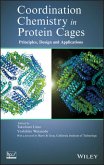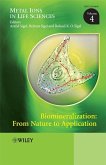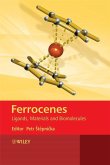Coordination Chemistry in Protein Cages (eBook, PDF)
Principles, Design, and Applications


Alle Infos zum eBook verschenken

Coordination Chemistry in Protein Cages (eBook, PDF)
Principles, Design, and Applications
- Format: PDF
- Merkliste
- Auf die Merkliste
- Bewerten Bewerten
- Teilen
- Produkt teilen
- Produkterinnerung
- Produkterinnerung

Hier können Sie sich einloggen

Bitte loggen Sie sich zunächst in Ihr Kundenkonto ein oder registrieren Sie sich bei bücher.de, um das eBook-Abo tolino select nutzen zu können.
Sets the stage for the design and application of new protein cages Featuring contributions from a team of international experts in the coordination chemistry of biological systems, this book enables readers to understand and take advantage of the fascinating internal molecular environment of protein cages. With the aid of modern organic and polymer techniques, the authors explain step by step how to design and construct a variety of protein cages. Moreover, the authors describe current applications of protein cages, setting the foundation for the development of new applications in biology,…mehr
- Geräte: PC
- mit Kopierschutz
- eBook Hilfe
- Größe: 76.68MB
![Coordination Chemistry in Protein Cages (eBook, ePUB) Coordination Chemistry in Protein Cages (eBook, ePUB)]() Takafumi UenoCoordination Chemistry in Protein Cages (eBook, ePUB)132,99 €
Takafumi UenoCoordination Chemistry in Protein Cages (eBook, ePUB)132,99 €![Bio-inorganic Hybrid Nanomaterials (eBook, PDF) Bio-inorganic Hybrid Nanomaterials (eBook, PDF)]() Bio-inorganic Hybrid Nanomaterials (eBook, PDF)205,99 €
Bio-inorganic Hybrid Nanomaterials (eBook, PDF)205,99 €![Biomineralization (eBook, PDF) Biomineralization (eBook, PDF)]() Biomineralization (eBook, PDF)356,99 €
Biomineralization (eBook, PDF)356,99 €![Silver in Organic Chemistry (eBook, PDF) Silver in Organic Chemistry (eBook, PDF)]() Silver in Organic Chemistry (eBook, PDF)116,99 €
Silver in Organic Chemistry (eBook, PDF)116,99 €![Ferrocenes (eBook, PDF) Ferrocenes (eBook, PDF)]() Ferrocenes (eBook, PDF)224,99 €
Ferrocenes (eBook, PDF)224,99 €![Bioinorganic Chemistry -- Inorganic Elements in the Chemistry of Life (eBook, PDF) Bioinorganic Chemistry -- Inorganic Elements in the Chemistry of Life (eBook, PDF)]() Wolfgang KaimBioinorganic Chemistry -- Inorganic Elements in the Chemistry of Life (eBook, PDF)49,99 €
Wolfgang KaimBioinorganic Chemistry -- Inorganic Elements in the Chemistry of Life (eBook, PDF)49,99 €![Chemistry of Metalloproteins (eBook, PDF) Chemistry of Metalloproteins (eBook, PDF)]() Joseph J. StephanosChemistry of Metalloproteins (eBook, PDF)113,99 €
Joseph J. StephanosChemistry of Metalloproteins (eBook, PDF)113,99 €-
-
-
Dieser Download kann aus rechtlichen Gründen nur mit Rechnungsadresse in A, B, BG, CY, CZ, D, DK, EW, E, FIN, F, GR, HR, H, IRL, I, LT, L, LR, M, NL, PL, P, R, S, SLO, SK ausgeliefert werden.
- Produktdetails
- Verlag: John Wiley & Sons
- Seitenzahl: 408
- Erscheinungstermin: 15. März 2013
- Englisch
- ISBN-13: 9781118571699
- Artikelnr.: 37757018
- Verlag: John Wiley & Sons
- Seitenzahl: 408
- Erscheinungstermin: 15. März 2013
- Englisch
- ISBN-13: 9781118571699
- Artikelnr.: 37757018
NATIVE PROTEIN CAGES 1 The Chemistry of Nature's Iron Biominerals in
Ferritin Protein Nanocages 3 Elizabeth C. Theil and Rabindra K. Behera 1.1
Introduction 3 1.2 Ferritin Ion Channels and Ion Entry 6 1.2.1 Maxi- and
Mini-Ferritin 6 1.2.2 Iron Entry 7 1.3 Ferritin Catalysis 8 1.3.1
Spectroscopic Characterization of -1,2 Peroxodiferric Intermediate (DFP) 8
1.3.2 Kinetics of DFP Formation and Decay 12 1.4 Protein-Based Ferritin
Mineral Nucleation and Mineral Growth 13 1.5 Iron Exit 16 1.6 Synthetic
Uses of Ferritin Protein Nanocages 17 1.6.1 Nanomaterials Synthesized in
Ferritins 18 1.6.2 Ferritin Protein Cages in Metalloorganic Catalysis and
Nanoelectronics 19 1.6.3 Imaging and Drug Delivery Agents Produced in
Ferritins 19 1.7 Summary and Perspectives 20 Acknowledgments 20 References
21 2 Molecular Metal Oxides in Protein Cages/Cavities 25 Achim M¿uller and
Dieter Rehder 2.1 Introduction 25 2.2 Vanadium: Functional Oligovanadates
and Storage of VO2+ in Vanabins 26 2.3 Molybdenum and Tungsten: Nucleation
Process in a Protein Cavity 28 2.4 Manganese in Photosystem II 33 2.5 Iron:
Ferritins, DPS Proteins, Frataxins, and Magnetite 35 2.6 Some General
Remarks: Oxides and Sulfides 38 References 38 PART II DESIGN OF
METALLOPROTEIN CAGES 3 De Novo Design of Protein Cages to Accommodate Metal
Cofactors 45 Flavia Nastri, Rosa Bruni, Ornella Maglio, and Angela Lombardi
3.1 Introduction 45 3.2 De Novo-Designed Protein Cages Housing Mononuclear
Metal Cofactors 47 3.3 De Novo-Designed Protein Cages Housing Dinuclear
Metal Cofactors 59 3.4 De Novo-Designed Protein Cages Housing Heme Cofactor
66 3.5 Summary and Perspectives 79 Acknowledgments 79 References 80 4
Generation of Functionalized Biomolecules Using Hemoprotein Matrices with
Small Protein Cavities for Incorporation of Cofactors 87 Takashi Hayashi
4.1 Introduction 87 4.2 Hemoprotein Reconstitution with an Artificial Metal
Complex 89 4.3 Modulation of the O2 Affinity of Myoglobin 90 4.4 Conversion
of Myoglobin into Peroxidase 95 4.4.1 Construction of a Substrate-Binding
Site Near the Heme Pocket 95 4.4.2 Replacement of Native Heme with Iron
Porphyrinoid in Myoglobin 99 4.4.3 Other Systems Used in Enhancement of
Peroxidase Activity of Myoglobin 100 4.5 Modulation of Peroxidase Activity
of HRP 102 4.6 Myoglobin Reconstituted with a Schiff Base Metal Complex 103
4.7 A Reductase Model Using Reconstituted Myoglobin 106 4.7.1 Hydrogenation
Catalyzed by Cobalt Myoglobin 106 4.7.2 A Model of Hydrogenase Using the
Heme Pocket of Cytochrome c 107 4.8 Summary and Perspectives 108
Acknowledgments 108 References 108 5 Rational Design of Protein Cages for
Alternative Enzymatic Functions 111 Nicholas M. Marshall, Kyle D. Miner,
Tiffany D. Wilson, and Yi Lu 5.1 Introduction 111 5.2 Mononuclear Electron
Transfer Cupredoxin Proteins 112 5.3 CuA Proteins 116 5.4 Catalytic Copper
Proteins 118 5.4.1 Type 2 Red Copper Sites 118 5.4.2 Other T2 Copper Sites
120 5.4.3 Cu, Zn Superoxide Dismutase 121 5.4.4 Multicopper Oxygenases and
Oxidases 122 5.5 Heme-Based Enzymes 124 5.5.1 Mb-Based Peroxidase and P450
Mimics 124 5.5.2 Mimicking Oxidases in Mb 125 5.5.3 Mimicking NOR Enzymes
in Mb 127 5.5.4 Engineering Peroxidase Proteins 128 5.5.5 Engineering
Cytochrome P450s 129 5.6 Non-Heme ET Proteins 131 5.7 Fe and Mn Superoxide
Dismutase 132 5.8 Non-Heme Fe Catalysts 133 5.9 Zinc Proteins 134 5.10
Other Metalloproteins 135 5.10.1 Cobalt Proteins 135 5.10.2 Manganese
Proteins 136 5.10.3 Molybdenum Proteins 137 5.10.4 Nickel Proteins 137
5.10.5 Uranyl Proteins 138 5.10.6 Vanadium Proteins 138 5.11 Summary and
Perspectives 139 References 142 PART III COORDINATION CHEMISTRY OF PROTEIN
ASSEMBLY CAGES 6 Metal-Directed and Templated Assembly of Protein
Superstructures and Cages 151 F. Akif Tezcan 6.1 Introduction 151 6.2
Metal-Directed Protein Self-Assembly 152 6.2.1 Background 152 6.2.2 Design
Considerations for Metal-Directed Protein Self-Assembly 153 6.2.3
Interfacing Non-Natural Chelates with MDPSA 155 6.2.4 Crystallographic
Applications of Metal-Directed Protein Self-Assembly 159 6.3
Metal-Templated Interface Redesign 162 6.3.1 Background 162 6.3.2
Construction of a Zn-Selective Tetrameric Protein Complex Through MeTIR 163
6.3.3 Construction of a Zn-Selective Protein Dimerization Motif Through
MeTIR 166 6.4 Summary and Perspectives 170 Acknowledgments 171 References
171 7 Catalytic Reactions Promoted in Protein Assembly Cages 175 Takafumi
Ueno and Satoshi Abe 7.1 Introduction 175 7.1.1 Incorporation of Metal
Compounds 176 7.1.2 Insight into Accumulation Process ofMetal Compounds 177
7.2 Ferritin as a Platform for Coordination Chemistry 177 7.3 Catalytic
Reactions in Ferritin 179 7.3.1 Olefin Hydrogenation 179 7.3.2
Suzuki-Miyaura Coupling Reaction in Protein Cages 182 7.3.3 Polymer
Synthesis in Protein Cages 185 7.4 Coordination Processes in Ferritin 188
7.4.1 Accumulation of Metal Ions 188 7.4.2 Accumulation of Metal Complexes
192 7.5 Coordination Arrangements in Designed Ferritin Cages 194 7.6
Summary and Perspectives 197 Acknowledgments 198 References 198 8
Metal-Catalyzed Organic Transformations Inside a Protein Scaffold Using
Artificial Metalloenzymes 203 V. K. K. Praneeth and Thomas R. Ward 8.1
Introduction 203 8.2 Enantioselective Reduction Reactions Catalyzed by
Artificial Metalloenzymes 204 8.2.1 Asymmetric Hydrogenation 204 8.2.2
Asymmetric Transfer Hydrogenation of Ketones 206 8.2.3 Artificial Transfer
Hydrogenation of Cyclic Imines 208 8.3 Palladium-Catalyzed Allylic
Alkylation 211 8.4 Oxidation Reaction Catalyzed by Artificial
Metalloenzymes 212 8.4.1 Artificial Sulfoxidase 212 8.4.2 Asymmetric
cis-Dihydroxylation 215 8.5 Summary and Perspectives 216 References 218
PART IV APPLICATIONS IN BIOLOGY 9 Selective Labeling and Imaging of Protein
Using Metal Complex 223 Yasutaka Kurishita and Itaru Hamachi 9.1
Introduction 223 9.2 Tag-Probe Pair Method Using Metal-Chelation System 225
9.2.1 Tetracysteine Motif/Arsenical Compounds Pair 225 9.2.2
Oligo-Histidine Tag/Ni(ii)-NTA Pair 227 9.2.3 Oligo-Aspartate
Tag/Zn(ii)-DpaTyr Pair 230 9.2.4 Lanthanide-binding Tag 235 9.3 Summary and
Perspectives 237 References 237 10 Molecular Bioengineering of Magnetosomes
for Biotechnological Applications 241 Atsushi Arakaki, Michiko Nemoto, and
Tadashi Matsunaga 10.1 Introduction 241 10.2 Magnetite Biomineralization
Mechanism in Magnetosome 242 10.2.1 Diversity of Magnetotactic Bacteria 242
10.2.2 Genome and Proteome Analyses of Magnetotactic Bacteria 244 10.2.3
Magnetosome Formation Mechanism 246 10.2.4 Morphological Control of
Magnetite Crystal in Magnetosomes 250 10.3 Functional Design of
Magnetosomes 251 10.3.1 Protein Display on Magnetosome by Gene Fusion
Technique 252 10.3.2 Magnetosome Surface Modification by In Vitro System
255 10.3.3 Protein-mediated Morphological Control of Magnetite Particles
257 10.4 Application 258 10.4.1 Enzymatic Bioassays 259 10.4.2 Cell
Separation 260 10.4.3 DNA Extraction 262 10.4.4 Bioremediation 264 10.5
Summary and Perspectives 266 Acknowledgments 266 References 266 PART V
APPLICATIONS IN NANOTECHNOLOGY 11 Protein Cage Nanoparticles for Hybrid
Inorganic-Organic Materials 275 Shefah Qazi, Janice Lucon, Masaki Uchida,
and Trevor Douglas 11.1 Introduction 275 11.2 Biomineral Formation in
Protein Cage Architectures 277 11.2.1 Introduction 277 11.2.2
Mineralization 278 11.2.3 Model for Synthetic Nucleation-Driven
Mineralization 279 11.2.4 Mineralization in Dps: A 12-Subunit Protein Cage
279 11.2.5 Icosahedral Protein Cages: Viruses 282 11.2.6 Nucleation of
Inorganic Nanoparticles Within Icosahedral Viruses 282 11.3 Polymer
Formation Inside Protein Cage Nanoparticles 283 11.3.1 Introduction 283
11.3.2 Azide-Alkyne Click Chemistry in sHsp and P22 285 11.3.3 Atom
Transfer Radical Polymerization in P22 287 11.3.4 Application as Magnetic
Resonance Imaging Contrast Agents 290 11.4 Coordination Polymers in Protein
Cages 292 11.4.1 Introduction 292 11.4.2 Metal-Organic Branched Polymer
Synthesis by Preforming Complexes 292 11.4.3 Coordination Polymer Formation
from Ditopic Ligands and Metal Ions 295 11.4.4 Altering Protein Dynamics by
Coordination: Hsp-Phen-Fe 296 11.5 Summary and Perspectives 298
Acknowledgments 298 References 298 12 Nanoparticles Synthesized and
Delivered by Protein in the Field of Nanotechnology Applications 305 Ichiro
Yamashita, Kenji Iwahori, Bin Zheng, and Shinya Kumagai 12.1 Nanoparticle
Synthesis in a Bio-Template 305 12.1.1 NP Synthesis by Cage-Shaped Proteins
for Nanoelectronic Devices and Other Applications 305 12.1.2 Metal Oxide or
Hydro-Oxide NP Synthesis in the Apoferritin Cavity 307 12.1.3 Compound
Semiconductor NP Synthesis in the Apoferritin Cavity 308 12.1.4 NP
Synthesis in the Apoferritin with the Metal-Binding Peptides 311 12.2
Site-Directed Placement of NPs 312 12.2.1 Nanopositioning of Cage-Shaped
Proteins 312 12.2.2 Nanopositioning of Au NPs by Porter Proteins 313 12.3
Fabrication of Nanodevices by the NP and Protein Conjugates 317 12.3.1
Fabrication of Floating Nanodot Gate Memory 318 12.3.2 Fabrication of
Single-Electron Transistor Using Ferritin 321 References 326 13 Engineered
"Cages" for Design of Nanostructured Inorganic Materials 329 Patrick B.
Dennis, Joseph M. Slocik, and Rajesh R. Naik 13.1 Introduction 329 13.2
Metal-Binding Peptides 331 13.3 Discrete Protein Cages 332 13.4 Heat-Shock
Proteins 334 13.5 Polymeric Protein and Carbohydrate Quasi-Cages 340 13.6
Summary and Perspectives 346 References 347 PART VI COORDINATION CHEMISTRY
INSPIRED BY PROTEIN CAGES 14 Metal-Organic Caged Assemblies 353 Sota Sato
and Makoto Fujita 14.1 Introduction 353 14.2 Construction of Polyhedral
Skeletons by Coordination Bonds 355 14.2.1 Geometrical Effect on Products
356 14.2.2 Structural Extension Based on Rigid, Designable Framework 358
14.2.3 Mechanistic Insight into Self-Assembly 366 14.3 Development of
Functions via Chemical Modification 366 14.3.1 Chemistry in the Hollow of
Cages 367 14.3.2 Chemistry on the Periphery of Cages 368 14.4 Metal-Organic
Cages for Protein Encapsulation 370 14.5 Summary and Perspectives 370
References 371 Index 375
NATIVE PROTEIN CAGES 1 The Chemistry of Nature's Iron Biominerals in
Ferritin Protein Nanocages 3 Elizabeth C. Theil and Rabindra K. Behera 1.1
Introduction 3 1.2 Ferritin Ion Channels and Ion Entry 6 1.2.1 Maxi- and
Mini-Ferritin 6 1.2.2 Iron Entry 7 1.3 Ferritin Catalysis 8 1.3.1
Spectroscopic Characterization of -1,2 Peroxodiferric Intermediate (DFP) 8
1.3.2 Kinetics of DFP Formation and Decay 12 1.4 Protein-Based Ferritin
Mineral Nucleation and Mineral Growth 13 1.5 Iron Exit 16 1.6 Synthetic
Uses of Ferritin Protein Nanocages 17 1.6.1 Nanomaterials Synthesized in
Ferritins 18 1.6.2 Ferritin Protein Cages in Metalloorganic Catalysis and
Nanoelectronics 19 1.6.3 Imaging and Drug Delivery Agents Produced in
Ferritins 19 1.7 Summary and Perspectives 20 Acknowledgments 20 References
21 2 Molecular Metal Oxides in Protein Cages/Cavities 25 Achim M¿uller and
Dieter Rehder 2.1 Introduction 25 2.2 Vanadium: Functional Oligovanadates
and Storage of VO2+ in Vanabins 26 2.3 Molybdenum and Tungsten: Nucleation
Process in a Protein Cavity 28 2.4 Manganese in Photosystem II 33 2.5 Iron:
Ferritins, DPS Proteins, Frataxins, and Magnetite 35 2.6 Some General
Remarks: Oxides and Sulfides 38 References 38 PART II DESIGN OF
METALLOPROTEIN CAGES 3 De Novo Design of Protein Cages to Accommodate Metal
Cofactors 45 Flavia Nastri, Rosa Bruni, Ornella Maglio, and Angela Lombardi
3.1 Introduction 45 3.2 De Novo-Designed Protein Cages Housing Mononuclear
Metal Cofactors 47 3.3 De Novo-Designed Protein Cages Housing Dinuclear
Metal Cofactors 59 3.4 De Novo-Designed Protein Cages Housing Heme Cofactor
66 3.5 Summary and Perspectives 79 Acknowledgments 79 References 80 4
Generation of Functionalized Biomolecules Using Hemoprotein Matrices with
Small Protein Cavities for Incorporation of Cofactors 87 Takashi Hayashi
4.1 Introduction 87 4.2 Hemoprotein Reconstitution with an Artificial Metal
Complex 89 4.3 Modulation of the O2 Affinity of Myoglobin 90 4.4 Conversion
of Myoglobin into Peroxidase 95 4.4.1 Construction of a Substrate-Binding
Site Near the Heme Pocket 95 4.4.2 Replacement of Native Heme with Iron
Porphyrinoid in Myoglobin 99 4.4.3 Other Systems Used in Enhancement of
Peroxidase Activity of Myoglobin 100 4.5 Modulation of Peroxidase Activity
of HRP 102 4.6 Myoglobin Reconstituted with a Schiff Base Metal Complex 103
4.7 A Reductase Model Using Reconstituted Myoglobin 106 4.7.1 Hydrogenation
Catalyzed by Cobalt Myoglobin 106 4.7.2 A Model of Hydrogenase Using the
Heme Pocket of Cytochrome c 107 4.8 Summary and Perspectives 108
Acknowledgments 108 References 108 5 Rational Design of Protein Cages for
Alternative Enzymatic Functions 111 Nicholas M. Marshall, Kyle D. Miner,
Tiffany D. Wilson, and Yi Lu 5.1 Introduction 111 5.2 Mononuclear Electron
Transfer Cupredoxin Proteins 112 5.3 CuA Proteins 116 5.4 Catalytic Copper
Proteins 118 5.4.1 Type 2 Red Copper Sites 118 5.4.2 Other T2 Copper Sites
120 5.4.3 Cu, Zn Superoxide Dismutase 121 5.4.4 Multicopper Oxygenases and
Oxidases 122 5.5 Heme-Based Enzymes 124 5.5.1 Mb-Based Peroxidase and P450
Mimics 124 5.5.2 Mimicking Oxidases in Mb 125 5.5.3 Mimicking NOR Enzymes
in Mb 127 5.5.4 Engineering Peroxidase Proteins 128 5.5.5 Engineering
Cytochrome P450s 129 5.6 Non-Heme ET Proteins 131 5.7 Fe and Mn Superoxide
Dismutase 132 5.8 Non-Heme Fe Catalysts 133 5.9 Zinc Proteins 134 5.10
Other Metalloproteins 135 5.10.1 Cobalt Proteins 135 5.10.2 Manganese
Proteins 136 5.10.3 Molybdenum Proteins 137 5.10.4 Nickel Proteins 137
5.10.5 Uranyl Proteins 138 5.10.6 Vanadium Proteins 138 5.11 Summary and
Perspectives 139 References 142 PART III COORDINATION CHEMISTRY OF PROTEIN
ASSEMBLY CAGES 6 Metal-Directed and Templated Assembly of Protein
Superstructures and Cages 151 F. Akif Tezcan 6.1 Introduction 151 6.2
Metal-Directed Protein Self-Assembly 152 6.2.1 Background 152 6.2.2 Design
Considerations for Metal-Directed Protein Self-Assembly 153 6.2.3
Interfacing Non-Natural Chelates with MDPSA 155 6.2.4 Crystallographic
Applications of Metal-Directed Protein Self-Assembly 159 6.3
Metal-Templated Interface Redesign 162 6.3.1 Background 162 6.3.2
Construction of a Zn-Selective Tetrameric Protein Complex Through MeTIR 163
6.3.3 Construction of a Zn-Selective Protein Dimerization Motif Through
MeTIR 166 6.4 Summary and Perspectives 170 Acknowledgments 171 References
171 7 Catalytic Reactions Promoted in Protein Assembly Cages 175 Takafumi
Ueno and Satoshi Abe 7.1 Introduction 175 7.1.1 Incorporation of Metal
Compounds 176 7.1.2 Insight into Accumulation Process ofMetal Compounds 177
7.2 Ferritin as a Platform for Coordination Chemistry 177 7.3 Catalytic
Reactions in Ferritin 179 7.3.1 Olefin Hydrogenation 179 7.3.2
Suzuki-Miyaura Coupling Reaction in Protein Cages 182 7.3.3 Polymer
Synthesis in Protein Cages 185 7.4 Coordination Processes in Ferritin 188
7.4.1 Accumulation of Metal Ions 188 7.4.2 Accumulation of Metal Complexes
192 7.5 Coordination Arrangements in Designed Ferritin Cages 194 7.6
Summary and Perspectives 197 Acknowledgments 198 References 198 8
Metal-Catalyzed Organic Transformations Inside a Protein Scaffold Using
Artificial Metalloenzymes 203 V. K. K. Praneeth and Thomas R. Ward 8.1
Introduction 203 8.2 Enantioselective Reduction Reactions Catalyzed by
Artificial Metalloenzymes 204 8.2.1 Asymmetric Hydrogenation 204 8.2.2
Asymmetric Transfer Hydrogenation of Ketones 206 8.2.3 Artificial Transfer
Hydrogenation of Cyclic Imines 208 8.3 Palladium-Catalyzed Allylic
Alkylation 211 8.4 Oxidation Reaction Catalyzed by Artificial
Metalloenzymes 212 8.4.1 Artificial Sulfoxidase 212 8.4.2 Asymmetric
cis-Dihydroxylation 215 8.5 Summary and Perspectives 216 References 218
PART IV APPLICATIONS IN BIOLOGY 9 Selective Labeling and Imaging of Protein
Using Metal Complex 223 Yasutaka Kurishita and Itaru Hamachi 9.1
Introduction 223 9.2 Tag-Probe Pair Method Using Metal-Chelation System 225
9.2.1 Tetracysteine Motif/Arsenical Compounds Pair 225 9.2.2
Oligo-Histidine Tag/Ni(ii)-NTA Pair 227 9.2.3 Oligo-Aspartate
Tag/Zn(ii)-DpaTyr Pair 230 9.2.4 Lanthanide-binding Tag 235 9.3 Summary and
Perspectives 237 References 237 10 Molecular Bioengineering of Magnetosomes
for Biotechnological Applications 241 Atsushi Arakaki, Michiko Nemoto, and
Tadashi Matsunaga 10.1 Introduction 241 10.2 Magnetite Biomineralization
Mechanism in Magnetosome 242 10.2.1 Diversity of Magnetotactic Bacteria 242
10.2.2 Genome and Proteome Analyses of Magnetotactic Bacteria 244 10.2.3
Magnetosome Formation Mechanism 246 10.2.4 Morphological Control of
Magnetite Crystal in Magnetosomes 250 10.3 Functional Design of
Magnetosomes 251 10.3.1 Protein Display on Magnetosome by Gene Fusion
Technique 252 10.3.2 Magnetosome Surface Modification by In Vitro System
255 10.3.3 Protein-mediated Morphological Control of Magnetite Particles
257 10.4 Application 258 10.4.1 Enzymatic Bioassays 259 10.4.2 Cell
Separation 260 10.4.3 DNA Extraction 262 10.4.4 Bioremediation 264 10.5
Summary and Perspectives 266 Acknowledgments 266 References 266 PART V
APPLICATIONS IN NANOTECHNOLOGY 11 Protein Cage Nanoparticles for Hybrid
Inorganic-Organic Materials 275 Shefah Qazi, Janice Lucon, Masaki Uchida,
and Trevor Douglas 11.1 Introduction 275 11.2 Biomineral Formation in
Protein Cage Architectures 277 11.2.1 Introduction 277 11.2.2
Mineralization 278 11.2.3 Model for Synthetic Nucleation-Driven
Mineralization 279 11.2.4 Mineralization in Dps: A 12-Subunit Protein Cage
279 11.2.5 Icosahedral Protein Cages: Viruses 282 11.2.6 Nucleation of
Inorganic Nanoparticles Within Icosahedral Viruses 282 11.3 Polymer
Formation Inside Protein Cage Nanoparticles 283 11.3.1 Introduction 283
11.3.2 Azide-Alkyne Click Chemistry in sHsp and P22 285 11.3.3 Atom
Transfer Radical Polymerization in P22 287 11.3.4 Application as Magnetic
Resonance Imaging Contrast Agents 290 11.4 Coordination Polymers in Protein
Cages 292 11.4.1 Introduction 292 11.4.2 Metal-Organic Branched Polymer
Synthesis by Preforming Complexes 292 11.4.3 Coordination Polymer Formation
from Ditopic Ligands and Metal Ions 295 11.4.4 Altering Protein Dynamics by
Coordination: Hsp-Phen-Fe 296 11.5 Summary and Perspectives 298
Acknowledgments 298 References 298 12 Nanoparticles Synthesized and
Delivered by Protein in the Field of Nanotechnology Applications 305 Ichiro
Yamashita, Kenji Iwahori, Bin Zheng, and Shinya Kumagai 12.1 Nanoparticle
Synthesis in a Bio-Template 305 12.1.1 NP Synthesis by Cage-Shaped Proteins
for Nanoelectronic Devices and Other Applications 305 12.1.2 Metal Oxide or
Hydro-Oxide NP Synthesis in the Apoferritin Cavity 307 12.1.3 Compound
Semiconductor NP Synthesis in the Apoferritin Cavity 308 12.1.4 NP
Synthesis in the Apoferritin with the Metal-Binding Peptides 311 12.2
Site-Directed Placement of NPs 312 12.2.1 Nanopositioning of Cage-Shaped
Proteins 312 12.2.2 Nanopositioning of Au NPs by Porter Proteins 313 12.3
Fabrication of Nanodevices by the NP and Protein Conjugates 317 12.3.1
Fabrication of Floating Nanodot Gate Memory 318 12.3.2 Fabrication of
Single-Electron Transistor Using Ferritin 321 References 326 13 Engineered
"Cages" for Design of Nanostructured Inorganic Materials 329 Patrick B.
Dennis, Joseph M. Slocik, and Rajesh R. Naik 13.1 Introduction 329 13.2
Metal-Binding Peptides 331 13.3 Discrete Protein Cages 332 13.4 Heat-Shock
Proteins 334 13.5 Polymeric Protein and Carbohydrate Quasi-Cages 340 13.6
Summary and Perspectives 346 References 347 PART VI COORDINATION CHEMISTRY
INSPIRED BY PROTEIN CAGES 14 Metal-Organic Caged Assemblies 353 Sota Sato
and Makoto Fujita 14.1 Introduction 353 14.2 Construction of Polyhedral
Skeletons by Coordination Bonds 355 14.2.1 Geometrical Effect on Products
356 14.2.2 Structural Extension Based on Rigid, Designable Framework 358
14.2.3 Mechanistic Insight into Self-Assembly 366 14.3 Development of
Functions via Chemical Modification 366 14.3.1 Chemistry in the Hollow of
Cages 367 14.3.2 Chemistry on the Periphery of Cages 368 14.4 Metal-Organic
Cages for Protein Encapsulation 370 14.5 Summary and Perspectives 370
References 371 Index 375







